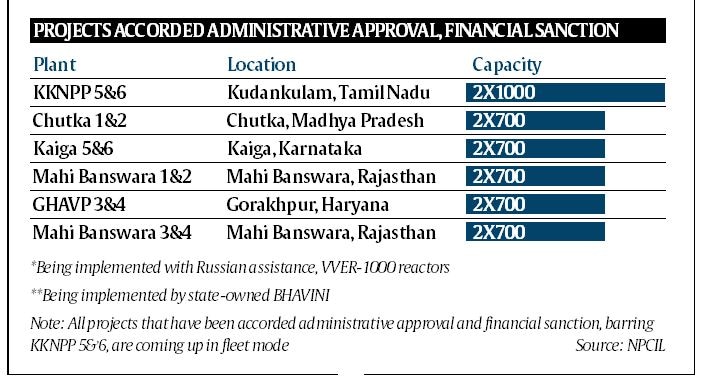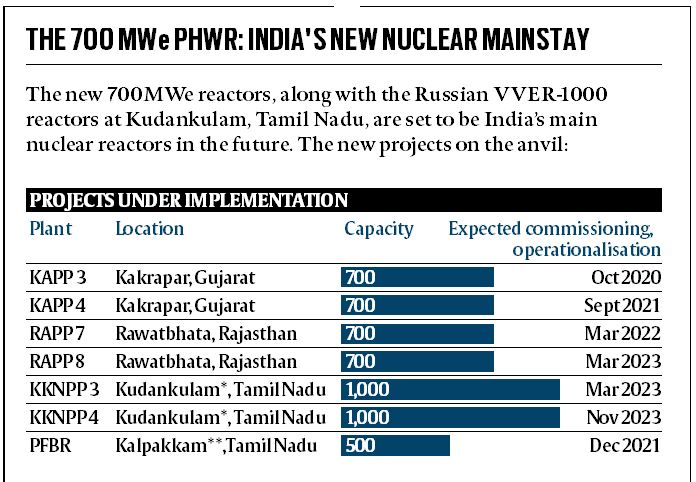KAKRAPAR-3
- This is a landmark event in India’s domestic civilian nuclear programme given that KAPP-3 is the country’s first 700 MWe (megawatt electric) unit, and the biggest indigenously developed variant of the Pressurised Heavy Water Reactor (PHWR)
- The PHWRs, which use natural uranium as fuel and heavy water as moderator, are the mainstay of India’s nuclear reactor fleet.
- Until now, the biggest reactor size of indigenous design was the 540 MWe PHWR, two of which have been deployed in Tarapur, Maharashtra
- The operationalisation of India’s first 700MWe reactor marks a significant scale-up in technology, both in terms of optimisation of its PHWR design — the new 700MWe unit addresses the issue of excess thermal margins — and an improvement in the economies of scale, without significant changes to the design of the 540 MWe reactor
- Four units of the 700MWe reactor are currently being built at Kakrapar (KAPP-3 and 4) and Rawatbhata (RAPS-7 and 8).
- The 700MWe reactors will be the backbone of a new fleet of 12 reactors to which the government accorded administrative approval and financial sanction in 2017, and which are to be set up in fleet mode
- As India works to ramp up its existing nuclear power capacity of 6,780 MWe to 22,480 MWe by 2031, the 700MWe capacity would constitute the biggest component of the expansion plan.
- Currently, nuclear power capacity constitutes less than 2% of the total installed capacity of 3,68,690 MW
- As the civilian nuclear sector gears up for the next frontier — building a 900 MWe Pressurised Water Reactor (PWR) of indigenous design — the experience of executing the larger 700MWe reactor design will come in handy, especially with regard to the improved capability of making large pressure vessels.


- Reactors are the heart of an atomic power plant, where a controlled nuclear fission reaction takes place that produces heat, which is used to generate steam that then spins a turbine to create electricity
- Fission is a process in which the nucleus of an atom splits into two or more smaller nuclei, and usually some byproduct particles
- When the nucleus splits, the kinetic energy of the fission fragments is transferred to other atoms in the fuel as heat energy, which is eventually used to produce steam to drive the turbines
- For every fission event, if at least one of the emitted neutrons on average causes another fission, a self-sustaining chain reaction will take place.
- A nuclear reactor achieves criticality when each fission event releases a sufficient number of neutrons to sustain an ongoing series of reactions
- The reactor core is made up of fuel rods, which are filled with uranium
- The fuel rods are surrounded by coolant water, which is kept under high pressure.
- The hot coolant water flows through a steam generator, where it heats water in a separate loop to create steam.
- The steam then drives a turbine, which generates electricity.
- The used steam is condensed back into water and returned to the steam generator.
- The radioactive waste produced by the reactor is stored in cooling ponds or underground repositories
State-owned Nuclear Power Corporation of India Ltd (NPCIL) had awarded the reactor-building contract for both KAPP-3 and 4 to Larsen & Toubro at an original contract value of Rs 844 crore.
The original cost of two 700 MWe units was pegged at Rs 11,500 crore, and the tariff per unit was originally calculated to be Rs 2.80 per unit (kWh) at 2010 prices (a cost of roughly Rs 8 crore per MWe). This costing is expected to have seen some escalation.
The capital investment for these projects is being funded with a debt-to-equity ratio of 70:30, with the equity part being funded from internal resources and through budgetary support
|
Previous year Questions
1.The function of heavy water in a nuclear reactor is to (UPSC CSE 2011)
(a) Slow down the speed of neutrons Answer: (a) 2. In Nuclear Power Station, Moderator is used to (ISRO Scientist Electrical 2014)
A. Absorb neutrons
B.Reduce the speed of neutrons
C. Accelerate the speed of nuetrons
D.Stop Chain reactions
Answer (B)
1.With growing energy needs should India keep on expanding its nuclear energy programme? Discuss the facts and fears associated with nuclear energy. (UPSC GS3 Mains 2018)
|




